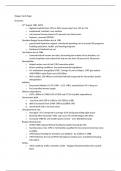Reagan Facts Page:
Economy:
- 13th August 1981, ERTA
o Highest band fell from 70% to 50%, lowest only from 14% to 11%
o emphasised ‘workfare’ over welfare
o cut personal income taxes by 25 percent over three years
o however, reversed (TEFRA)
- Omnibus Budget Reconciliation Act of 1981
o passed with bipartisan support, introduced spending cuts to around 200 programs
including education, health, and housing programs
o Medicare & Medicaid not cut
- Tax Reform Act of 1986
o Lowered federal income tax rates, decreasing the number of tax brackets, cut
certain loopholes and reduced the top tax rate from 50 percent to 28 percent
- Deregulation
o Helped reduce cost of fuel (1981 executive order)
o Worse working conditions, less environmental regulations,
o S+L institutions deregulated 1982 - Savings & Loans Collapse, 1987 gov bailout –
1989 FIRREA under Bush cost $150 billion
o HUD scandal, 138 officials convicted/indicted/suspected for misconduct (partly
deregulation)
- Inflation
o Decreased inflation (13.5% 1980 – 6.2% 1982), stayed below 5% in long run
o Fed controlled money supply
- Defence expenditure
o $393.1 billion in 1988 (5.8% of GDP and 27.3% of public expenditure)
- Government debt
o rose from 26% GDP in 1980 to 41% GDP by 1988
o deficit increased from $59bil 1980 to $208bil 1983
o meant Bush had to increase taxes
- Unemployment rate
o Averaged 7.5% (compared to average 6.6% during preceding eight years)
o Declined after December 1982, rate was 5.4% month Reagan left office
o Increased 1980-85, 250 textiles plants closed – over 300,000 lost jobs
- Reagan Housing Cuts
o (1980-1988) reduced federal funding for public housing by 65%
o homelessness crisis: 1985 3.7mil families qualified for low-income home but none
available
o 1984 federal funding for homeless was $300mil - $1.6 billion in 1988
o 1987 McKinney Act set up FEMA (emergency medical care, transitional housing,
education)
- Strikes
o 1981 13,000 air traffic controllers strike – Reagan threatened them then sacked
them




